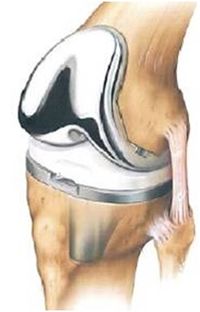Total Knee Joint Replacement Revision Surgery: Difference between revisions
No edit summary |
(added video) |
||
| Line 29: | Line 29: | ||
* Periprosthetic fracture | * Periprosthetic fracture | ||
* Metallosis<br> | * Metallosis<br> | ||
{{#ev:youtube|https://www.youtube.com/watch?v=ayYTyUdRjrs|width}}<ref>Joseph Gondusky,M.D. Revisional Knee Replacement. Available from: https://www.youtube.com/watch?v=ayYTyUdRjrs (last accessed 4.3.2019)</ref> | |||
== Clinical Presentation == | == Clinical Presentation == | ||
add text here relating to the clinical presentation of the condition<br> | add text here relating to the clinical presentation of the condition<br> | ||
Revision as of 08:00, 4 March 2019
Original Editor - Your name will be added here if you created the original content for this page.
Lead Editors
Clinically Relevant Anatomy[edit | edit source]
Total Knee Joint Replacement (TKR) revision surgery is an orthopaedic surgical procedure in which the prosthetic pieces(s) of the previous TKR surgery are removed. New prosthetic pieces are then replaced within knee joint joint. The components being; the femoral condyle component; the tibial plateau component; the polyethylene space; the patella component. All or some of these may be replaced depending on reason for replacement.
Revisional TKR surgery is a more complicated operation requiring longer time in theatre and rehabilitation is slower and takes a more cautious approach.[1]
Mechanism of Injury / Pathological Process[edit | edit source]
Many reasons exist for the failure of a TKR. A meta analysis in 2011 found that TKA for OA has a revision rate of < 5% within 10 years.[2] The reason for this failure can be classified into long or short term reasons.[1]
Short term pathological process or injury include
- Infection
- Mechanical failure
- Implant loosening from failed procedure
Long term pathological process or injury include
- Loosening due to wearing of the TKR ( life span of a replacement varies from approximately 10 to 20 years).
- Stiffness
- Pain
- Dislocation
Other reasons include
- Fall
- Periprosthetic fracture
- Metallosis
Clinical Presentation[edit | edit source]
add text here relating to the clinical presentation of the condition
Diagnostic Procedures[edit | edit source]
add text here relating to diagnostic tests for the condition
Outcome Measures[edit | edit source]
add links to outcome measures here (see Outcome Measures Database)
Management / Interventions[edit | edit source]
add text here relating to management approaches to the condition
Differential Diagnosis[edit | edit source]
add text here relating to the differential diagnosis of this condition
Resources[edit | edit source]
add appropriate resources here
References[edit | edit source]
- ↑ 1.0 1.1 Healthline. What is Knee Replacement Revision Surgery. Available from: https://www.healthline.com/health/total-knee-replacement-surgery/revision#1 (last accessed 4.3.2019)
- ↑ Lützner J, Hübel U, Kirschner S, Günther KP, Krummenauer F. Long-term results in total knee arthroplasty. A meta-analysis of revision rates and functional outcome. Available from: https://www.ncbi.nlm.nih.gov/pubmed/21258774 (last accessed 4.3.2019)
- ↑ Joseph Gondusky,M.D. Revisional Knee Replacement. Available from: https://www.youtube.com/watch?v=ayYTyUdRjrs (last accessed 4.3.2019)







